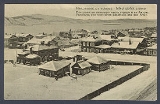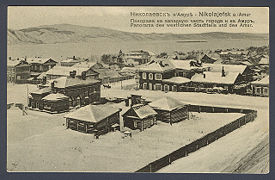
Nikolayevsk Incident
Encyclopedia
The was a series of events from February through March 1920 during the Allied intervention in the Russian Civil War
, cumulating in the massacre of several hundred Japanese expatriates
and most of the Russian inhabitants of the town of Nikolayevsk-on-Amur
in the Russian Far East
.
 Nikolayevsk-on-Amur was occupied in September 1918 by the Imperial Japanese Army
Nikolayevsk-on-Amur was occupied in September 1918 by the Imperial Japanese Army
as part of Japan's Siberian Intervention
force. In early February 1920, the town had a Japanese civilian community of around 450 people, and a military garrison of 350 men from the Imperial Japanese Army
's 14th Infantry Division
. In addition to the Japanese presence, the Russian White Army housed a garrison of roughly 300 men. The total civilian population at the time was around 15,000. In January 1920, the town was surrounded by a partisans
force nearly 4,000 strong under the command of anarchist Yakov Triapitsyn, who was loosely allied with the Bolshevik
Red Army
.
On February 24, 1920, realizing that he was outnumbered and far from reinforcement, the commander of the Japanese garrison allowed Triapitsyn's troops to enter the town under a flag of truce. However, Triapitsyn began to round up and execute White Movement
supporters, the only force holding his hand being the small Japanese garrison. On 10 March, he issued an ultimatum to the garrison to voluntarily disarm, to which he was sure the Japanese would not agree. Therefore the Japanese intervened, launching a surprise attack on 12 March 1920. The attack failed and most of the Japanese troops died, the remaining few only surrendered when the Japanese high command ordered them to do so. Even so Triapitsyn decided to take revenge, which resulted in the execution of the surviving garrison and the slaughter of all but 122 Japanese civilians - in all around 700 Japanese died shortly thereafter.
After this, he was free to start a reign of terror and execute all those civilians he deemed dangerous to his forces. Being short with ammunition, one of the methods to execute the victims was to stab them with a bayonet and thrust them in a hole under the ice of the river Amur. Several thousand inhabitants of the town were killed like this and with other execution methods.
In late May, as a Japanese relief expedition approached, Triapitsyn executed all of the remaining inhabitants of the town, both Japanese and Russian, and burned the town to the ground.
The Japanese government lodged a protest against the Bolshevik government in Moscow
, demanding compensation. The Russian government responded by capturing and executing Triapitsyn; however, the Japanese government felt that this was not sufficient, and used the incident as an excuse to occupy the northern half of Sakhalin
island, and to delay diplomatic recognition
of the Soviet Union
until 1925.
Allied Intervention in the Russian Civil War
The Allied intervention was a multi-national military expedition launched in 1918 during World War I which continued into the Russian Civil War. Its operations included forces from 14 nations and were conducted over a vast territory...
, cumulating in the massacre of several hundred Japanese expatriates
Japanese people in Russia
Japanese people in Russia form a small part of the worldwide community of Nikkeijin. They count various notable political figures among their number.-Early settlement:...
and most of the Russian inhabitants of the town of Nikolayevsk-on-Amur
Nikolayevsk-on-Amur
Nikolayevsk-on-Amur often romanized as Nikolayevsk-na-Amure, is a town and the administrative center of Nikolayevsky District of Khabarovsk Krai, Russia located on the Amur River close to its liman in the Pacific Ocean...
in the Russian Far East
Russian Far East
Russian Far East is a term that refers to the Russian part of the Far East, i.e., extreme east parts of Russia, between Lake Baikal in Eastern Siberia and the Pacific Ocean...
.

Imperial Japanese Army
-Foundation:During the Meiji Restoration, the military forces loyal to the Emperor were samurai drawn primarily from the loyalist feudal domains of Satsuma and Chōshū...
as part of Japan's Siberian Intervention
Siberian Intervention
The ', or the Siberian Expedition, of 1918–1922 was the dispatch of troops of the Entente powers to the Russian Maritime Provinces as part of a larger effort by the western powers and Japan to support White Russian forces against the Bolshevik Red Army during the Russian Civil War...
force. In early February 1920, the town had a Japanese civilian community of around 450 people, and a military garrison of 350 men from the Imperial Japanese Army
Imperial Japanese Army
-Foundation:During the Meiji Restoration, the military forces loyal to the Emperor were samurai drawn primarily from the loyalist feudal domains of Satsuma and Chōshū...
's 14th Infantry Division
14th Division (Imperial Japanese Army)
was an infantry division in the Imperial Japanese Army. Its call sign was the .-History:The 14th Division was one of four divisions raised in the closing stages of the Russo-Japanese War...
. In addition to the Japanese presence, the Russian White Army housed a garrison of roughly 300 men. The total civilian population at the time was around 15,000. In January 1920, the town was surrounded by a partisans
Partisan (military)
A partisan is a member of an irregular military force formed to oppose control of an area by a foreign power or by an army of occupation by some kind of insurgent activity...
force nearly 4,000 strong under the command of anarchist Yakov Triapitsyn, who was loosely allied with the Bolshevik
Bolshevik
The Bolsheviks, originally also Bolshevists , derived from bol'shinstvo, "majority") were a faction of the Marxist Russian Social Democratic Labour Party which split apart from the Menshevik faction at the Second Party Congress in 1903....
Red Army
Red Army
The Workers' and Peasants' Red Army started out as the Soviet Union's revolutionary communist combat groups during the Russian Civil War of 1918-1922. It grew into the national army of the Soviet Union. By the 1930s the Red Army was among the largest armies in history.The "Red Army" name refers to...
.
On February 24, 1920, realizing that he was outnumbered and far from reinforcement, the commander of the Japanese garrison allowed Triapitsyn's troops to enter the town under a flag of truce. However, Triapitsyn began to round up and execute White Movement
White movement
The White movement and its military arm the White Army - known as the White Guard or the Whites - was a loose confederation of Anti-Communist forces.The movement comprised one of the politico-military Russian forces who fought...
supporters, the only force holding his hand being the small Japanese garrison. On 10 March, he issued an ultimatum to the garrison to voluntarily disarm, to which he was sure the Japanese would not agree. Therefore the Japanese intervened, launching a surprise attack on 12 March 1920. The attack failed and most of the Japanese troops died, the remaining few only surrendered when the Japanese high command ordered them to do so. Even so Triapitsyn decided to take revenge, which resulted in the execution of the surviving garrison and the slaughter of all but 122 Japanese civilians - in all around 700 Japanese died shortly thereafter.
After this, he was free to start a reign of terror and execute all those civilians he deemed dangerous to his forces. Being short with ammunition, one of the methods to execute the victims was to stab them with a bayonet and thrust them in a hole under the ice of the river Amur. Several thousand inhabitants of the town were killed like this and with other execution methods.
In late May, as a Japanese relief expedition approached, Triapitsyn executed all of the remaining inhabitants of the town, both Japanese and Russian, and burned the town to the ground.
The Japanese government lodged a protest against the Bolshevik government in Moscow
Moscow
Moscow is the capital, the most populous city, and the most populous federal subject of Russia. The city is a major political, economic, cultural, scientific, religious, financial, educational, and transportation centre of Russia and the continent...
, demanding compensation. The Russian government responded by capturing and executing Triapitsyn; however, the Japanese government felt that this was not sufficient, and used the incident as an excuse to occupy the northern half of Sakhalin
Sakhalin
Sakhalin or Saghalien, is a large island in the North Pacific, lying between 45°50' and 54°24' N.It is part of Russia, and is Russia's largest island, and is administered as part of Sakhalin Oblast...
island, and to delay diplomatic recognition
Diplomatic recognition
Diplomatic recognition in international law is a unilateral political act with domestic and international legal consequences, whereby a state acknowledges an act or status of another state or government in control of a state...
of the Soviet Union
Soviet Union
The Soviet Union , officially the Union of Soviet Socialist Republics , was a constitutionally socialist state that existed in Eurasia between 1922 and 1991....
until 1925.

